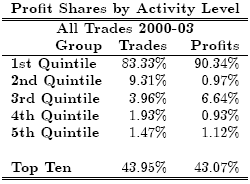Does sharing ideas and actions with a community help make individual active traders successful? In the March 2008 version of their paper entitled “Experts Online: An Analysis of Trading Activity in a Public Internet Chat Room”, Bruce Mizrach and Susan Weerts study a group of active traders who voluntarily posted their trades in real time in a free public Internet chat room called Activetrader. Using data on 8,967 trades by 676 traders from four snapshots (64 total trading days) during 2000-2003, along with survey responses from 67 of these traders, they conclude that:
- The typical trader among the 67 surveyed is a middle-aged male with about $200,000 exposure to the stock market and five years trading experience. Each typically trades four stocks per day, choosing entry points based on momentum, technical analysis and news and exit points based on technical analysis (implemented via target percentage gains and stop losses). The two most popular technical analysis tools are chart patterns and moving averages.
- For the entire sample of 676 traders, 55% are profitable after transaction costs. In aggregate, they achieve a statistically significant four-factor (market, size, book-to-market, momentum) daily alpha of 0.17% (positive in all four snapshots). On an annualized basis, the most active 20% of the sample achieves a 13.3% average return.
- These traders typically use large capitalization stocks that have high trading volumes and high betas.
- They do not exhibit the disposition effect, holding winners 25% longer than losers.
- Shorting accounts for over 27% of all trades in the sample, with 42% of traders shorting at least once. Success rates on long and short trades are roughly equal, but short trades generate almost double the profit per trade. Traders who trade both short and long are more likely to be profitable overall.
- Traders do influence each other, with recent posts substantially affecting the probability that subsequent orders will be buy or sell.
- Individual trader profitability strongly persists from snapshot to snapshot. Highly concentrated portfolios have the highest profitability, suggesting that traders who stick with a few familiar stocks are more profitable. It seems that traders who stay active improve both their overall skill and their expertise in trading particular stocks.
The following table, taken from the paper, provides percentages of trades (out of the total 8,967) and profits (out of the total $1,071,244) sorted by trader activity level. All quintiles are profitable. The “Top Ten” are the ten most active traders in the sample.

While individual traders in this study do better than those tracked in prior studies, the profit and profitability calculations here involve quite a few assumptions.
In summary, individual active traders on average may be able to beat the market when collaborating on trading methods and opportunities.